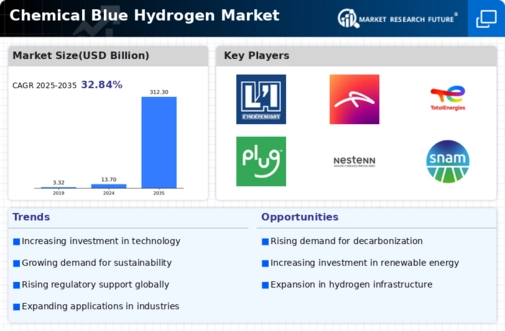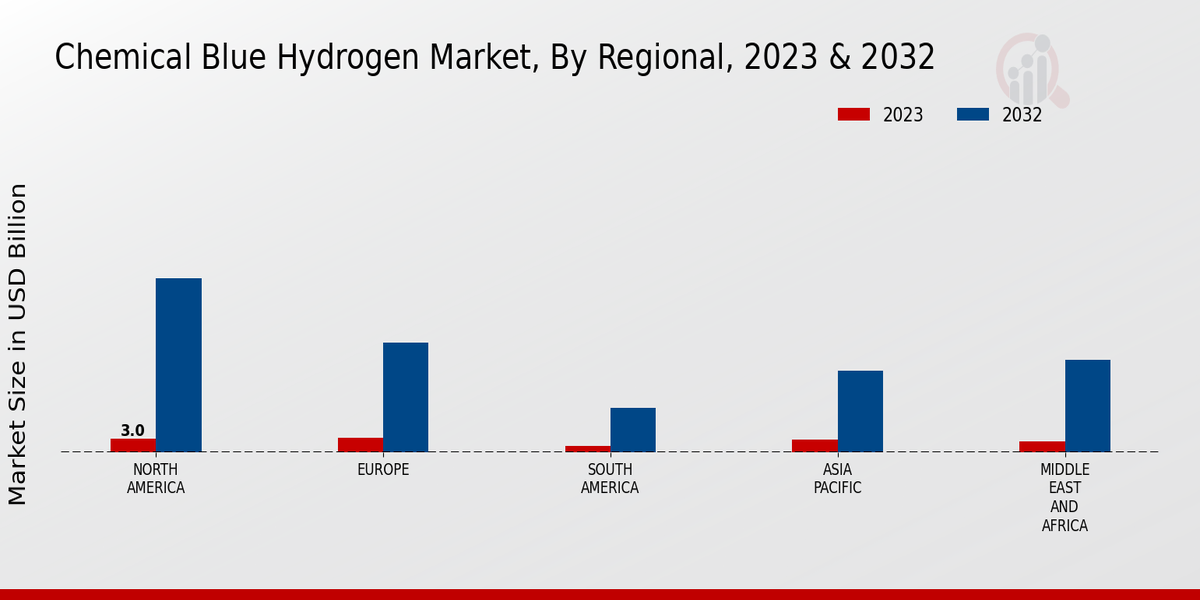Market Growth Projections
The Global Chemical Blue Hydrogen Market Industry is on a trajectory of remarkable growth, with projections indicating a market size of 312.3 USD Billion by 2035. This growth is underpinned by various factors, including rising demand for clean energy, technological advancements, and supportive government policies. The compound annual growth rate of 32.84% from 2025 to 2035 highlights the increasing investment and interest in blue hydrogen as a sustainable energy solution. The market's expansion reflects a broader shift towards decarbonization and the pursuit of net-zero emissions, positioning blue hydrogen as a cornerstone of future energy systems.
Rising Demand for Clean Energy
The Global Chemical Blue Hydrogen Market Industry is experiencing a surge in demand for clean energy solutions. As nations strive to meet their climate targets, the transition from fossil fuels to cleaner alternatives becomes imperative. Blue hydrogen, produced from natural gas with carbon capture and storage, offers a viable pathway to reduce greenhouse gas emissions. In 2024, the market is projected to reach 13.7 USD Billion, reflecting the growing recognition of blue hydrogen as a key player in the energy transition. This trend is likely to accelerate as governments implement policies that favor low-carbon technologies, further driving investment in the sector.
Growing Industrial Applications
The Global Chemical Blue Hydrogen Market Industry is witnessing an expansion in industrial applications, particularly in sectors such as refining, ammonia production, and steel manufacturing. Blue hydrogen serves as a cleaner alternative to traditional hydrogen sources, helping industries reduce their carbon footprints. For instance, the refining sector is increasingly adopting blue hydrogen to meet stringent emissions regulations. This trend is expected to contribute to the market's growth, as industries seek to align with sustainability goals. The versatility of blue hydrogen in various applications positions it as a critical component in the transition towards a low-carbon economy.
Government Policies and Incentives
Government policies and incentives play a crucial role in shaping the Global Chemical Blue Hydrogen Market Industry. Many countries are implementing supportive frameworks to promote the adoption of hydrogen technologies, including tax credits, grants, and research funding. For example, initiatives aimed at reducing carbon emissions have led to increased investments in blue hydrogen projects. This supportive environment is expected to drive a compound annual growth rate of 32.84% from 2025 to 2035. As governments prioritize energy security and environmental sustainability, the demand for blue hydrogen is likely to rise, further solidifying its position in the energy landscape.
Investment in Infrastructure Development
Investment in infrastructure development is a key driver of the Global Chemical Blue Hydrogen Market Industry. As the demand for blue hydrogen increases, the need for robust infrastructure, including production facilities, transportation networks, and storage solutions, becomes paramount. Governments and private entities are channeling funds into building the necessary infrastructure to support the hydrogen economy. This investment is anticipated to facilitate the scaling up of blue hydrogen production and distribution, thereby enhancing market accessibility. The establishment of a comprehensive hydrogen infrastructure is likely to play a pivotal role in achieving the projected market growth and fostering a sustainable energy future.
Technological Advancements in Hydrogen Production
Technological innovations in hydrogen production processes are significantly influencing the Global Chemical Blue Hydrogen Market Industry. Advances in carbon capture and storage technologies enhance the efficiency and economic viability of blue hydrogen production. For instance, improvements in membrane technology and catalytic processes are expected to lower production costs and increase yield. As a result, the market is poised for substantial growth, with projections indicating a market size of 312.3 USD Billion by 2035. These advancements not only bolster the competitiveness of blue hydrogen but also align with global efforts to decarbonize the energy sector.













